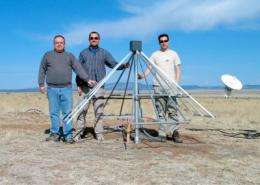Scientists make first discovery using revolutionary long wavelength demonstrator array

Scientists from NRL's Space Science and Remote Sensing Divisions, in collaboration with researchers from the University of New Mexico and the National Radio Astronomy Observatory located in Socorro, N.M., have generated the first scientific results from the Long Wavelength Demonstrator Array (LWDA). The measurements were obtained during field tests and calibration of two prototype antennas for the much larger Long Wavelength Array (LWA), which will eventually consist of nearly 13,000 similar antennas.
Utilizing radio emissions from the approximately 300 year-old Cassiopeia A (Cas A) supernova remnant (SNR)—one of the brightest astronomical radio sources in the sky—to establish baseline measurements, NRL scientist and National Research Council (NRC) postdoctoral fellow Dr. Jake Hartman utilized the LWDA to confirm and extend a study initiated by fellow NRL-NRC postdoc Dr. Joseph Helmboldt.
Using NRAO's Very Large Array (VLA) radio telescope, Dr. Helmboldt's research showed that the gradually weakening Cas A displays signs of a "softer" smooth, secular decrease and an apparent shorter term variability at frequencies below 100 MHz.
"Cas A has long been known to be fading, but the slower, seemingly irregular decrease at frequencies lower than 100 MHz has remained controversial," said Dr Namir Kassim, astronomer and LWA project scientist, NRL. "Dr. Hartman's discovery reaffirms this supposition and provides strong support that more frequent time sampling will be needed to determine whether the shorter term variations contain a non-random component."
Dr. Helmboldt's measurements were able to significantly improve constraints on the smooth secular decrease, confirming earlier indications that the decrease was slower than originally determined several decades ago. He was also able to verify earlier indications of variations on shorter timescales, including the possibility that they might contain a sinusoidal component.
Scientifically, these new measurements taken by Dr. Hartman are significant because they must be explained by diffusive shock acceleration theory—which helps describe how the blast wave from a relatively recent supernova explosion like Cas A is able to accelerate relativistic particles and generate radio emission. The theory must account both for the relatively smooth, longer-term rate at which the emission is gradually fading, as well as the shorter-term variability that is likely related to the properties of the region into which the SNR is expanding.
"The result is exciting because it represents 'first science', and is increasingly intriguing as it is based on measurements from only two dipole antennas, as compared to the more than 13,000 that will eventually comprise the full LWA," said Dr. Paul Ray, astronomer, NRL. "For a project whose broader goals encompass engaging and training a next generation of young radio scientists we are proud that this first astronomical result emerged from the work of two postdocs, neither of whom were experts in this area of research."
Once completed, the LWA will provide an entirely novel view of the sky in the radio frequency range of 20-80 MHz, currently one of the most poorly explored regions of the electromagnetic spectrum in astronomy. The LWA will be able to make sensitive high-resolution images, scanning the sky rapidly for new and transient sources of radio waves that may represent the explosion of distant massive stars or detect emissions from planets outside of our own solar system and previously unknown objects or phenomena.
"We're now laying the infrastructure for the first LWA antenna station," said Joe Craig, LWA system engineer, UNM. "It's really an exciting period for everyone involved."
LWA will also provide an unparalleled measure of turbulence and waves in the Earth's ionosphere, together with unique diagnostics of phenomena manifested through the Sun-Earth connection also known as "Space Weather."
More information: Dr. Hartman's work describing his LWDA-based measurements has been published as an LWA technical memorandum, while Dr. Helmboldt's paper on the secular decrease of Cas A, based on the combined VLA and LWDA data, will appear in the September 2009 issue of the Astronomical Journal.
Source: Naval Research Laboratory (news : web)

















